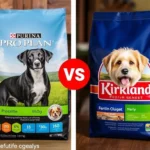
Understanding the dietary needs of our canine companions is crucial for their overall health and well-being. As pet owners, we often find ourselves weighing the options between commercial dog food and homemade meals for our furry friends. A common question arises: is it cheaper to make your own dog food? This inquiry is not just about costs but also about the nutritional quality and the health implications of what we feed our dogs. Let’s dive into the world of dog nutrition, explore the cost dynamics of homemade versus commercial options, and offer practical insights for dog owners.
Understanding Dog Nutrition
Essential Nutrients for Dogs
To ensure our dogs thrive, we must understand their essential nutritional requirements. Dogs, like humans, need a balanced diet consisting of:
- Proteins: Vital for growth, repair, and maintenance of body tissues. Proteins can come from meat, fish, and plant-based sources.
- Carbohydrates: Provide energy and aid in digestion. Common sources include grains and vegetables.
- Fats: Necessary for energy and the absorption of certain vitamins. Healthy fats, like those from fish oil, are beneficial for skin and coat health.
- Vitamins and minerals: Essential for various bodily functions, including bone health and immune support.
Common Dog Food Ingredients
When considering dog food, it’s essential to be aware of common ingredients:
- Types of proteins: Options include chicken, beef, fish, and legumes. Each source has a unique nutritional profile.
- Grains vs. grain-free options: Some dogs thrive on grain-based diets, while others may benefit from grain-free formulations. It’s important to know your dog’s unique needs.
- Vegetables and fruits suitable for dogs: Carrots, peas, blueberries, and pumpkin can be great additions to your dog’s diet, providing fiber and essential nutrients.
Nutritional Needs by Dog Age and Size
Dogs have unique dietary needs based on their life stages and size:
- Puppies: Require higher protein and fat content to support growth and development.
- Adult dogs: Need balanced nutrition to maintain health and energy levels.
- Senior dogs: Often benefit from diets lower in calories but enriched with joint-supporting supplements.
- Special dietary needs: Dogs with allergies or health conditions may require specialized diets, which can be more easily managed through homemade food.
The Cost of Commercial Dog Food
Overview of Dog Food Pricing
Dog food prices can vary significantly based on quality and type. Here’s a general breakdown:
- Kibble: Typically ranges from $0.50 to $3.00 per pound, depending on the brand and ingredients.
- Wet food: Often priced between $1.00 and $4.00 per can or pouch.
- Raw diets: Can range from $2.00 to $5.00 per pound, with higher costs for organic or specialty products.
Hidden Costs of Commercial Dog Food
While the sticker price of commercial dog food may seem reasonable, there are hidden costs to consider:
- Long-term health implications: Poor-quality ingredients can lead to health issues, resulting in increased vet bills.
- Potential vet bills: Dogs fed low-quality diets may face health problems that require medical attention, leading to unexpected expenses.
- Environmental impact and ethical considerations: Some owners may prefer to invest in higher-quality, sustainably sourced ingredients, affecting long-term costs.
Making Your Own Dog Food
Benefits of Homemade Dog Food
Creating homemade dog food can offer several advantages:
- Control over ingredients: You can select high-quality, fresh ingredients that cater directly to your dog’s health needs.
- Tailored nutrition: Homemade meals allow you to adjust recipes based on your dog’s specific dietary requirements.
- Potential cost savings: In some cases, especially for larger dogs, making your own food can be more cost-effective than purchasing premium commercial options.
Costs Involved in Homemade Dog Food
When considering homemade dog food, it’s essential to evaluate all associated costs:
- Ingredient sourcing: The price of ingredients will vary based on where you buy them. Organic products may be more expensive but can offer health benefits.
- Equipment and preparation time: Factor in the cost of pots, pans, and storage containers. Also, consider the time required for meal prep.
- Comparison of costs: Conduct a cost analysis comparing your homemade recipes with commercial dog food to see which option fits your budget better.
Easy Homemade Dog Food Recipes
Here are a few simple recipes to get you started:
Basic Recipe for Adult Dogs:
– 1 cup of lean ground turkey
– 1/2 cup of brown rice
– 1/4 cup of peas and carrots
– 1/4 cup of chicken broth (low sodium)
Puppy Recipe:
– 1 cup of chicken, shredded
– 1/2 cup of quinoa
– 1/4 cup of pumpkin puree
– 1/4 cup of spinach
Senior Dog Recipe:
– 1 cup of lean beef
– 1/2 cup of sweet potato, cooked and mashed
– 1/4 cup of green beans
– 1/4 cup of low-fat yogurt
To balance your dog’s diet, consider supplementing homemade meals with high-quality commercial dog food.
Nutritional Guidelines for Homemade Dog Food
Balancing Macronutrients
To achieve a balanced diet, it’s essential to follow general guidelines:
- Recommended ratios: Aim for a diet consisting of 40% protein, 50% carbohydrates, and 10% fats.
- Incorporating supplements: Consider adding omega fatty acids for coat health and glucosamine for joint support, especially for senior dogs.
Common Mistakes to Avoid
When creating homemade dog food, be cautious of common pitfalls:
- Over-reliance on single ingredients: Variety is key to a balanced diet.
- Neglecting essential nutrients: Ensure all essential vitamins and minerals are included.
- Miscalculating portion sizes: Accurately measure portions according to your dog’s size and activity level to avoid overfeeding or underfeeding.
Evaluating the Cost-Effectiveness
Cost Analysis: Homemade vs. Commercial
To determine the cost-effectiveness of making your own dog food, consider the following:
- Creating a budget: Calculate the monthly cost of ingredients for homemade meals and compare it against your current commercial dog food expenses.
- Time investment vs. financial savings: Weigh the time you spend preparing meals against the potential savings. For some, the health benefits and peace of mind may outweigh the costs.
Real-Life Case Studies
Many dog owners have switched to homemade diets and have reported positive outcomes:
- Testimonials: Owners often share stories of improved health and energy levels in their pets after transitioning to homemade meals.
- Comparative analysis: Look at the long-term costs of both diets; some owners find that homemade meals save money in the long run due to fewer vet visits.
Conclusion
In summary, understanding your dog’s nutritional needs and evaluating the costs of both commercial and homemade dog food can empower you to make informed decisions. While is it cheaper to make your own dog food? can vary based on numerous factors, many dog owners find that the benefits of homemade meals extend beyond just cost. Balancing nutrition with budget considerations is key to providing the best care for your four-legged family members. Take time to assess your dog’s unique needs and dietary preferences, and consider experimenting with homemade options for a healthier, happier pup.
FAQs
Common Questions about Homemade Dog Food
-
Is homemade dog food safe?
Yes, as long as it is prepared with the right ingredients and balanced nutrition in mind. -
How do I know if my dog’s diet is balanced?
Consult with a veterinarian who specializes in canine nutrition or use reputable resources to ensure your recipes meet all dietary requirements. -
Can I feed my dog human food?
Many human foods are safe for dogs, but it’s important to know which ones are suitable and how to prepare them properly.
Additional Tips
- Tips for transitioning to homemade food: Gradually introduce homemade meals to avoid digestive upset.
- Storage and preparation advice: Always store homemade dog food in airtight containers and freeze portions to maintain freshness.
By navigating the landscape of dog nutrition, we can make choices that enhance our dogs’ lives while being mindful of costs.









